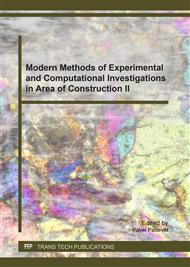p.128
p.136
p.142
p.148
p.153
p.159
p.167
p.172
p.178
Synthesized Fields Fluctuations by Means of Wang Tiles and Local Tilings
Abstract:
In this paper, we present the concept of the Wang tiles method that compresses the stochastic microstructure into a small set of statistical volume elements – tiles. These tiles are then used for modeling of materials with heterogeneous stochastic microstructures and to streamline the calculations on the micro-scale level. In the following text, we focus on the fluctuation fields that are obtained as the main tiling reconstructed from the micro-mechanical quantities evaluated on individual tiles. But because of the non-local character of mechanical quantities the synthesized fluctuation field contain jumps between adjacent tiles. To prevent this phenomenon, the nearest surrounding tiles are included into the evaluation for each tile from the main tiling. Then the mechanical response is solved on these small so-called local tilings and results for middle tiles are saved. The main tiling is then synthesized using these results and further can be utilized as an enrichment functions for the finite element method.
Info:
Periodical:
Pages:
178-183
Citation:
Online since:
March 2017
Authors:
Price:
Сopyright:
© 2017 Trans Tech Publications Ltd. All Rights Reserved
Share:
Citation:


